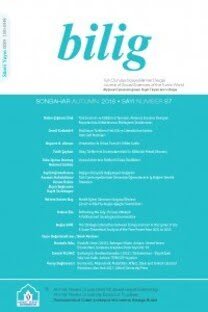Şakarim’in Passionerlik Yönünün Dilsel Kimliğinden Yola Çıkarak Tanıtılması
Makalede dilsel kimliğinden hareketle Kazak şairi Şakarim Kudayberdiulı’nın passionerlik (ihtiraslılık, tutkululuk) yönü araştırılmaktadır.
Şakarim’in eserlerini incelemek ancak Kazakistan’ın Bağımsızlık kazanmasından sonra mümkün hale gelmiştir. Şairin söylevi incelendiğinde
onun passioner bir kimliğe sahip olduğu görülebilir. Çünkü Şakarim
sadece kendi dönemiyle sınırlı kalmayıp Kazak geleceğinin nasıl olması
gerektiğini de belirlemiştir. Şair sözleriyle toplumu düzeltmeyi, insanlara inançlı olmayı, Yaratan’ı tanımayı öğretmeyi amaçlamıştır. Böylelikle passioner toplum kurmaya döğru ulusu yönlendirmek istemiştir.
Buna bağlı olarak makalede passionerlik teorisinin anlamıyla ilgili
bilimsel açıklamalar ve düşünceler üzerinde de durulmuştur.
Anahtar Kelimeler:
Şakarim söylevi, passionerlik teorisi, Türk halkı, etnolengüistik, dilsel kimlik, etnokültürel tanım, Kazakistan
Revealing Shakarim’s Passionate Nature via His Linguistic Personality
The article is concerned with revealing Shakarim’s passionate nature
by means of his linguistic personality. It became possible to study
Shakarim’s legacy, when Kazakhstan gained independence. Investigating discourse of the poet, we can reveal that he was a writer of
passionate personality level Shakarim didn’t only describe his epoch,
but also predicted the future of the Kazakh people. The purpose of his
works is improvement of society, invoking the people to God-fearing,
cognition of the God. So he tried to guide people to create passionate
society. In this regard, the article analyzes scientific opinions and
conclusions about the meaning of the theory of passion.
Keywords:
Discourse of Shakarim, the theory of passion, Turkic Nation, ethnoliguistics, linguistic individual, ethno cultural view, Kazakhstan,
___
- Abdigaziev, B. (1992). Abay’s Traditions and Shakarim. Almaty: Kazakh University.
- Abdigaziuly, B. (2008). Shakarim’s World. Almaty: Raritet.
- Abdumanapov, S. (2004). Life and Works of L. N. Gumilyov. Astana: ENU.
- Baitursinuly, A. (2003). Literary Cognition: Studies and Poems. Almaty: Atamura.
- Baitursinuly, A. (1913). «The Genealogy of Turkic, Kirgiz, Kazakh famous Khans». Social and Political Newspaper Kazakh 28: 12.
- Descart, R. (1989). Works in Two Volumes. V. 1. Moscow.
- Gumilyov, L. N. (2010). Ethnogenesis and biosphere of the Earth. Moscow: AST: Astrel.
- Irmukhanov, B. (2012). “Passionary Leo Gumilyov”. Modern education Scientific Journal 3: 107-112.
- Issayev, S. (1996). History of Kazakh Literary Language. Almaty: Ana Tili.
- Iztyleyova, S. D. (2007). Shakarim’s Poetics. PhD Thesis. Almaty.
- Karaulov, Yu. N. (1987). The Russian Language and Linguistic Personality. Moscow: Science.
- Konuratbayeva, Zh. (2005). Idioms In The Kazakh Poetic Language at the Beginning of the 20th Century. Almaty: Arus.
- Kudaiberdiev, Sh. (1988). Poems, Legends, Instructive Words. Almaty: Zhazushi.
- Kudaiberdiuly, Sh. (2000). My Faith. Almaty: Arus.
- Kudaiberdiuly, Sh. (2004). A Complete Collection of Poems in Two Volumes 1. Almaty: Zhazushi.
- Maqayin, M. (2007). «Writer, Historian, Philosopher». Shakarim’s Science 1: 4-49.
- Momunova, B. (2008). The Language of Shakarim’s Poetry. Almaty: Arus.
- Mukhamedkhanov, K. (1995). Abay’s Followers. Almaty: Atamura.
- Mukhamedkhanuly, K. (2007). «Shakhkarim». The Science of Shakarim 1: 50-100.
- Mukhamedkhanov, K. (2008). A Multi-Volume Collection of Stories. V. 6. Almaty: El- Shezhire.
- Pimenova, M. V. (2011). The Linguistic Picture of the World. Saint-Petersburg: Library of the Saint-Petersburg State University. 106.
- Salkunbay, A. (2011). The Apex Reached by Shakarim. Almaty: Kazakh University.
- Seidimbek (2004). «Gumilev». Social and political newspaper The Independent Kazakhstan 247-248: 3.
- Seysenylu, D. (2008). Shakarim. Astana: Foliant.
- Sydykov, E. (2008). Shakarim and Alashorda. Almaty: Raritet.
- Syzdykova, R. (1993). The History of the Kazakh Literary Language. Almaty: Ana Tili.
- Syzdykova, R. (1995). The Beauty of Abay’s Words. Almaty: Sanat.
- Syzdyk, R. (2005). The Power of Words. Almaty: Atamura.
- Takhan, S. Sh. (2015). Texts in Sociocultural Dimension. Astana: Master.
- Toynbee, A. J. (1946). A Study of History. Oxford: Oxford University Press.
- Vernadsky, V. I. (1989). Biosphere and Noosphere. Moscow: Science.
- Yessim, G. (2008a). The Science of Conscience. Almaty: Raritet.
- Yessim, G. (2008b). Wise Shakarim. Almaty: Atamura.
- http://turkacadem.kz/kz/vp.php?idd=83 (15.09.2014).
- www.writers.kz/journals/?ID=10...183 (14.01.2015).
- http://libsib.ru/filosofiya/teoreticheskie-osnovaniya-filosofii-problemi-ponyatiya-printsipi/ Filosofskaya-kartina-mira (10.09.2014).
- ISSN: 1301-0549
- Yayın Aralığı: Yılda 4 Sayı
- Başlangıç: 1996
- Yayıncı: Ahmet Yesevi Üniversitesi
Sayıdaki Diğer Makaleler
Tarih ve Edebiyat Metinleri Bağlamlı Dizin ve İşlevsel Sözlüğü Sistemi (TEBDİZ)
Kökü Mazide Bir Âti: Türk Edebiyatı İsimler Sözlüğü II (20. Yüzyıldan Günümüze 1860-1985) Projesi
Türk Cumhuriyetlerinin KKTC’yi Tanıma Stratejisinin Esasları
İsrail Tarih Ders Kitaplarında Türk İstiklal Savaşı ve Cumhuriyet Dönemi
Selim TEZCAN, Mehmet Sadık GÜR, Alper SARIBAŞ
“Mecmû’a” Ve “Mecmû’a-i Eş’âr” Kavramlarının Zübdetü’l-Eş’âr ve Zeyllerindeki Kullanımları Üzerine
Siyaset Felsefesi Açısından Dede Korkut Hikâyeleri
Türk Klasik Eserlerinin Dijital Ortama Aktarılması Projesi (E-Kitap)
Şakarim’in Passionerlik Yönünün Dilsel Kimliğinden Yola Çıkarak Tanıtılması
Zhanar KONYRATBAYEVA, Serikkyl SATENOVA, Ordaly KONYRATBAYEV
